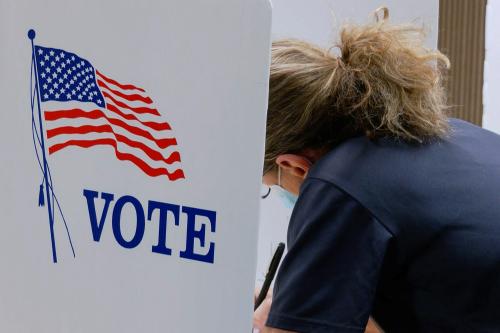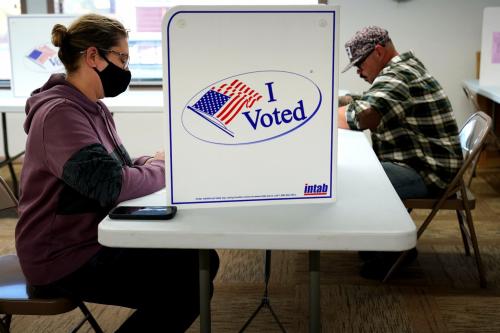Republicans are thrashing around trying to get themselves out of the abortion ban they have tried to win for so many decades. Senator Lindsey Graham (R-SC) was the first. In the fall of 2022, just months after the Supreme Court struck down Roe v. Wade, he proposed legislation calling for a national abortion ban after 15 weeks. So far, this bill has gone nowhere. Then, in 2023, gubernatorial candidate Glenn Youngkin of Virginia put the 15-week abortion ban at the center of his campaign to help the GOP take full control of the Virginia legislature. Rather than holding one house and picking up the other, he lost both. Recently, former President Donald Trump—who often brags about appointing the three Supreme Court justices who made possible the repeal of Roe v. Wade—offered his own way out of the thicket by applauding the fact that states now can decide the issue for themselves. And in Arizona, the Republican Senate candidate, Kari Lake, is trying to rally the party around the notion of a 15-week ban instead of the 1864 near total ban their court just affirmed, even though she’s facing criticism for this on the far right. Meanwhile, the Wall Street Journal came out with a poll showing that abortion was the number one issue—by far—for suburban women voters in swing states.
In each instance (and there will be more) we find Republicans desperately trying to find a position on the issue that makes their base and the other parts of their coalition happy.
It doesn’t exist, and here’s why—abortion is an integral part of health care for women.
Since 2022, when the Supreme Court eviscerated Roe in the Dobbs case, we have been undergoing a reluctant national seminar in obstetrics and gynecology. All over the country, legislators—mostly male—are discovering that pregnancy is not simple. Pregnancies go wrong for many reasons, and when they do, the fetus needs to be removed. One of the first to discover this reality was Republican State Representative Neal Collins of South Carolina. He was brought to tears by the story of a South Carolina woman whose water broke just after 15 weeks of pregnancy. Obstetrics lesson #1—a fetus can’t live after the water breaks. But “lawyers advised doctors that they could not remove the fetus, despite that being the recommended medical course of action.” And so, the woman was sent home to miscarry on her own, putting her at risk of losing her uterus and/or getting blood poisoning.
A woman from Austin, Texas had a similar story—one that eventually made its way into a heart-wrenching ad by the Biden campaign. Amanda Zurawski was 18 weeks pregnant when her water broke. Rather than remove the fetus, doctors in Texas sent her home where she miscarried—and developed blood poisoning (sepsis) so severe that she may never get pregnant again. Note that in both cases the medical emergency happened after 15 weeks—late miscarriages are more likely to have serious medical effects than early ones. The 15-week idea, popular among Republicans seeking a way out of their quagmire, doesn’t conform to medical reality.
Over in Arkansas, a Republican state representative learned that his niece was carrying a fetus who lacked a vital organ, meaning that it would never develop normally and either die in utero or right after birth. Obstetrics lesson #2—severe fetal abnormalities happen. He changed his position on the Arkansas law saying, “Who are we to sit in judgment of these women making a decision between them and their physician and their God above?”
In a case that gained national attention, Kate Cox, a Texas mother of two, was pregnant with her third child when the fetus was diagnosed with a rare condition called Trisomy 18, which usually ends in miscarriage or in the immediate death of the baby. Continuing this doomed pregnancy put Cox at risk of uterine rupture and would make it difficult to carry another child. Obstetrics lesson #3—continuing to carry a doomed pregnancy can jeopardize future pregnancies. And yet the Texas Attorney General blocked an abortion for Cox and threatened to prosecute anyone who took care of her, and the Texas Supreme Court ruled that her condition did not meet the statutory exception for “life-threatening physical condition.”
So, she and her husband eventually went to New Mexico for the abortion.
Obstetrics lesson #4—miscarriages are very common, affecting approximately 30% of pregnancies. While many pass without much drama and women heal on their own—others cause complications that require what’s known as a D&C for dilation and curettage. This involves scraping bits of pregnancy tissue out of the uterus to avoid infection. When Christina Zielke of Maryland was told that her fetus had no heartbeat, she opted to wait to miscarry naturally.
While waiting, she and her husband traveled to Ohio for a wedding where she began to bleed so heavily that they had to go to an emergency room. A D&C would have stopped the bleeding, but in Ohio, doctors worried that they would be criminally charged under the new abortion laws and sent her home in spite of the fact that she was still bleeding heavily and in spite of the fact that doctors in Maryland had confirmed that her fetus had no heartbeat. Eventually her blood pressure dropped, and she passed out from loss of blood and returned to the hospital where a D&C finally stopped the bleeding.
These are but a few of the horror stories that will continue to mount in states with partial or total bans on abortion. As these stories accumulate, the issue will continue to have political punch. We have already seen the victory of pro-choice referenda in deep red conservative states like Kansas, Kentucky, Montana, and Ohio; and in swing states like Michigan and in deep blue states like California and Vermont. In an era where almost everything is viewed through a partisan lens, abortion rights transcend partisanship.
And more referenda are coming in November. The expectation is that at least some, if not most, of the pro-choice voters likely to be mobilized by the abortion issue will help Democrats up and down the ballot. As a result, Democratic campaigns are working hard to make sure the public knows that Republicans are responsible. The following table shows the states that are likely to have referenda in November. States where the referenda are already on the ballot are at the end of the table. Once the deadline occurs for filing signatures, a battle will take place in each state as pro-life groups seek to challenge enough signatures to keep the referenda from getting on the ballot, which is why pro-choice groups are gathering many more signatures than needed.
What is the likely political impact? Judging from what we’ve seen so far, these referenda are likely to succeed even in the most conservative states. The question is: What is the likely impact on other races? There are two states, Arizona and Florida, where turnout for the pro-choice referenda could help President Biden. Biden won Arizona last time but by a very small margin. Trump won Florida by just over three percentage points, so putting it in Biden’s column is tougher but not impossible. Besides the presidential, there are Senate races in Arizona, Nevada, and Maryland that could be affected by the abortion referenda. Arizona and Nevada are competitive races. Maryland should be a Democratic seat given how strong Democrats are there, but the popular ex-governor, a moderate non-Trump Republican, is running for Senate, increasing the odds that a Republican could take the seat. Finally, there are seven competitive House seats that could also be affected by turnout for the abortion referenda—two in Arizona, one in Colorado, one in Nebraska, and three in New York.1 Deep red states like Arkansas, Missouri, and South Dakota don’t have any races that are likely to be so impacted by the abortion referenda that the election outcomes would flip the seats from one party to the other, but any large increase in Democratic-leaning voters could affect races in the future.
Ever since the Supreme Court decided the Dobbs case, analysts have underestimated the size of the pro-choice vote. In hindsight, there’s no question that it was instrumental in blocking the expected red wave in the 2022 midterms and instrumental in putting both houses of the Virginia legislature in Democratic hands in 2023. Biden’s first abortion ads will, no doubt, be followed by others, and Republicans will try to come up with ways of softening their stances—but in the end, this could be the most decisive issue in the election.
-
Footnotes
- Arizona congressional districts one and six; Colorado district eight; Nebraska district two; and New York districts four, 17, and 19.










Commentary
Abortion and the 2024 election: There is no easy way out for Republicans
April 17, 2024